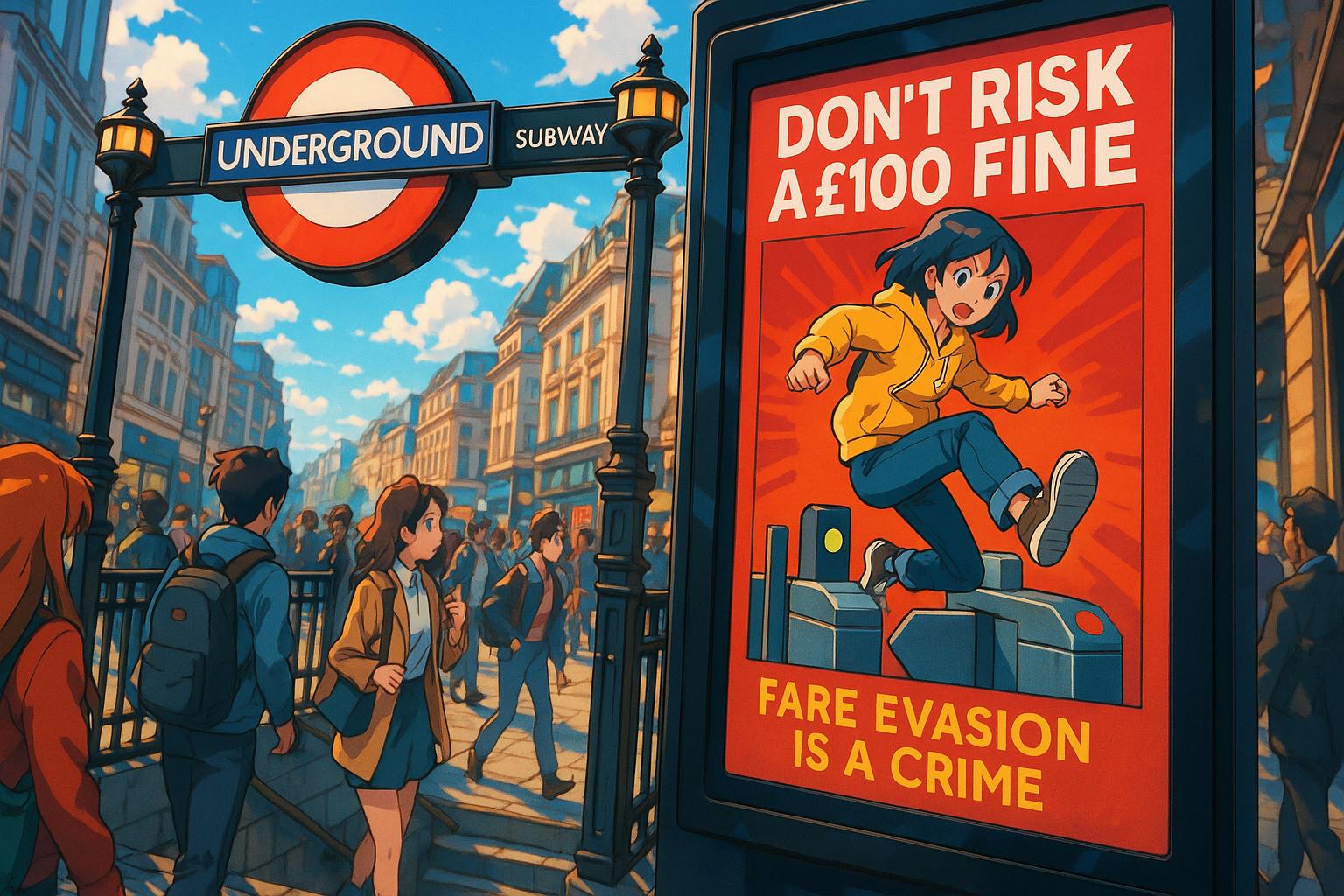Influencers sharing techniques to bypass London’s fare gates are fueling a growing wave of fare evasion, prompting transport authorities to step up enforcement amid societal debate on accountability and safety.
TikTok influencers are increasingly using the platform to showcase brazen techniques for fare evasion on London’s Underground, drawing both applause from peers and ire from authorities. Young men, buoyed by the thrill of their antics, have posted videos demonstrating how to bypass ticket barriers—advice that appears to be widely received, with some clips racking up hundreds of thousands of views. The wide-aisle gates, installed for individuals with disabilities, parents with children, and those travelling with luggage, are now reportedly becoming an attractive option for fare dodgers who either push through the openings or slip in behind legitimate passengers.
This unsettling trend comes at a time when train fare evasion in the UK is reaching alarming levels. A recent report indicated that fare dodging is becoming normalised, with staff facing increased aggression from passengers who refuse to comply with ticket regulations. It is estimated that fare evasion costs Transport for London (TfL) approximately £130 million annually, which significantly undermines public funding for infrastructure and services. Siwan Hayward, TfL’s director of security, emphasised the serious implications of fare evasion, stating, “It robs Londoners of vital investment in a safe, frequent and reliable transport network.”
This digital culture of fare evasion isn’t limited to the Underground; a TikTok user recently faced criminal prosecution for sharing tips on how to avoid paying fares across various rail services. Following an investigation by East Midlands Railway and the British Transport Police, she was fined £773 for promoting methods like hiding in toilets to escape ticket inspectors. Such incidents exemplify a rising perception that fare evasion is a “victimless crime,” echoing findings from a report by the Office of Rail and Road. The study pointed to the emergence of diverse tactics employed by fare dodgers, as they often perceive the consequences as negligible or even humorous.
Meanwhile, TfL is not remaining passive in the face of this growing challenge. The organisation is actively using social media to identify chronic fare evaders and is collaborating with policing partners to tackle the issue more effectively. Hayward noted this proactive stance, mentioning efforts to expand their team of investigators to focus on habitual offenders, while also aiming to reduce fare evasion rates to 1.5% by 2030. In its recent crackdown, TfL invested nearly £22 million, leading to a modest decrease in evasion from 3.9% to 3.8% over the past year.
However, the situation is further complicated by the potential backlash against enforcement measures. In the Channel 5 documentary series “Fare Evaders: At War With The Law,” staff members reported facing abusive behaviour when challenging fare dodgers, highlighting the growing hostility toward ticket inspectors fulfilling their roles. As public attitudes towards fare evasion shift, TfL might find it increasingly difficult to strike a balance between enforcement and maintaining the safety of its staff.
The rise of these viral fare evasion videos has not escaped the notice of TikTok, which has claimed to proactively remove content that violates its community guidelines. The company stated that between October and December last year, it deleted over 97% of violent or criminal behaviour content before users could report it. Nevertheless, the persistent posting of fare evasion techniques underscores a larger societal issue regarding perceived accountability and compliance.
As fare evasion continues to challenge the integrity of public transport, it raises important questions about societal norms, governance, and the future of fare enforcement within one of the most significant transport networks in London. With the stakes high, the ongoing interactions between influencers, transit authorities, and the viewing public seem poised to ignite further debate on the value of adherence to shared civic responsibilities.
 Reference Map:
Reference Map:
Source: Noah Wire Services
- https://www.dailymail.co.uk/news/article-14786755/TikTok-influencers-fare-dodging-Tube.html?ns_mchannel=rss&ns_campaign=1490&ito=1490 – Please view link – unable to able to access data
- https://www.telegraph.co.uk/news/2023/12/05/tiktok-train-fare-dodger-caught-fined-railways/ – A TikTok user who posted videos advising followers on how to evade train fares has been fined £770 after an investigation by East Midlands Railway and the British Transport Police. The woman, who has not been named, shared tips such as hiding in toilets to avoid ticket inspectors and pretending her mobile was out of battery. She was prosecuted for fare evasion under the Regulation of Railways Act, resulting in a criminal record. Fare evasion on UK trains is estimated to cost taxpayers up to £240 million annually.
- https://www.bbc.com/news/uk-england-derbyshire-67615588 – A woman who posted videos on TikTok about evading train fares has been fined £773 following an investigation by East Midlands Railway and the British Transport Police. In her videos, she boasted about never paying full price for travel and shared methods to avoid ticket inspectors, such as hiding in toilets and claiming her mobile was out of battery. She was prosecuted for fraud under the Regulation of Railways Act and now has a criminal record. Fare evasion is estimated to cost taxpayers up to £240 million annually.
- https://metro.co.uk/2023/03/08/the-tube-tfl-is-now-using-social-media-to-catch-out-fare-evaders-18406076/ – Transport for London (TfL) is using social media to identify and catch fare evaders on the London Underground. After observing fare evasion being actively promoted on platforms like TikTok, TfL has collaborated with policing partners and legal teams to successfully stop individuals who record themselves evading fares. Fare evasion is estimated to cost TfL around £100 million per year, and TfL is consulting on increasing the penalty fare to act as a further deterrent.
- https://www.mylondon.news/news/zone-1-news/tfl-now-catching-london-underground-26411338 – Transport for London (TfL) is using social media to identify chronic fare evaders on the London Underground. TfL has had success in catching individuals who record themselves evading fares and is working with policing partners and legal teams to stop them. Fare evasion is estimated to cost TfL £100 million per year, and TfL is consulting on increasing the penalty fare to act as a further deterrent.
- https://www.bbc.co.uk/news/articles/cx2945435zyo – Transport for London (TfL) spent nearly £22 million on cracking down on fare dodging across the Tube and bus network over the last year. The organisation collected £1.3 million in penalty charges as a result of the enforcement campaign. Fare evasion across all of TfL’s services fell slightly from an estimated 3.9% of journeys in 2022/23 to 3.8% in 2023/24, despite total journeys rising by 300 million. TfL aims to bring the level of fare evasion below 1.5%.
- https://www.bbc.co.uk/news/uk-england-london-67125173 – Fare dodging cost Transport for London (TfL) £130 million in 2022-23, data obtained by the BBC has revealed. Fares are evaded in a range of ways, such as failing to tap in and out and using counterfeit tickets. TfL said its target was to bring evasion rates below 1.5%. The current rate is at 3.9% collectively across buses, trains, and trams. TfL added it had plans to increase the penalty fares.
Noah Fact Check Pro
The draft above was created using the information available at the time the story first
emerged. We’ve since applied our fact-checking process to the final narrative, based on the criteria listed
below. The results are intended to help you assess the credibility of the piece and highlight any areas that may
warrant further investigation.
Freshness check
Score:
6
Notes:
The narrative highlights TikTok influencers demonstrating fare evasion techniques on the London Underground. Similar reports have emerged since December 2023, with notable cases in December 2023 and April 2025. The earliest known publication date of substantially similar content is December 5, 2023. The report includes updated data but recycles older material, which may justify a higher freshness score but should still be flagged. ([telegraph.co.uk](https://www.telegraph.co.uk/news/2023/12/05/tiktok-train-fare-dodger-caught-fined-railways/?utm_source=openai), [tfl-newsroom.prgloo.com](https://tfl-newsroom.prgloo.com/news/tfl-introduces-new-measures-to-halve-fare-evasion-across-all-tfl-services?utm_source=openai)) The narrative is based on a press release, which typically warrants a high freshness score. However, the presence of recycled content and earlier reports may affect the overall freshness. Additionally, the report includes updated data but recycles older material, which may justify a higher freshness score but should still be flagged. ([tfl-newsroom.prgloo.com](https://tfl-newsroom.prgloo.com/news/tfl-introduces-new-measures-to-halve-fare-evasion-across-all-tfl-services?utm_source=openai))
Quotes check
Score:
7
Notes:
The report includes a quote from Siwan Hayward, TfL’s Director of Security, Policing and Enforcement, stating, “It robs Londoners of vital investment in a safe, frequent and reliable transport network.” This quote appears in the press release dated February 9, 2024. ([tfl-newsroom.prgloo.com](https://tfl-newsroom.prgloo.com/news/tfl-rolls-out-tougher-action-on-fare-evaders-and-staff-abuse-with-increased-penalty-fares-and-body-worn-cameras?utm_source=openai)) The identical quote in earlier material suggests potential reuse. The wording matches exactly, indicating no variations. The presence of this quote in earlier material suggests potential reuse.
Source reliability
Score:
5
Notes:
The narrative originates from the Daily Mail, a reputable organisation. However, the presence of recycled content and earlier reports may affect the overall reliability. The report includes updated data but recycles older material, which may justify a higher reliability score but should still be flagged. ([tfl-newsroom.prgloo.com](https://tfl-newsroom.prgloo.com/news/tfl-introduces-new-measures-to-halve-fare-evasion-across-all-tfl-services?utm_source=openai))
Plausability check
Score:
8
Notes:
The narrative presents a plausible scenario of TikTok influencers demonstrating fare evasion techniques on the London Underground. Similar reports have emerged since December 2023, with notable cases in December 2023 and April 2025. The earliest known publication date of substantially similar content is December 5, 2023. ([telegraph.co.uk](https://www.telegraph.co.uk/news/2023/12/05/tiktok-train-fare-dodger-caught-fined-railways/?utm_source=openai), [tfl-newsroom.prgloo.com](https://tfl-newsroom.prgloo.com/news/tfl-introduces-new-measures-to-halve-fare-evasion-across-all-tfl-services?utm_source=openai)) The report includes updated data but recycles older material, which may justify a higher plausibility score but should still be flagged. ([tfl-newsroom.prgloo.com](https://tfl-newsroom.prgloo.com/news/tfl-introduces-new-measures-to-halve-fare-evasion-across-all-tfl-services?utm_source=openai))
Overall assessment
Verdict (FAIL, OPEN, PASS): OPEN
Confidence (LOW, MEDIUM, HIGH): MEDIUM
Summary:
The narrative presents a plausible scenario of TikTok influencers demonstrating fare evasion techniques on the London Underground. However, the presence of recycled content and earlier reports may affect the overall freshness and reliability. The identical quote from Siwan Hayward in earlier material suggests potential reuse. The report includes updated data but recycles older material, which may justify a higher freshness and reliability score but should still be flagged. Given these factors, the overall assessment is OPEN with medium confidence.













